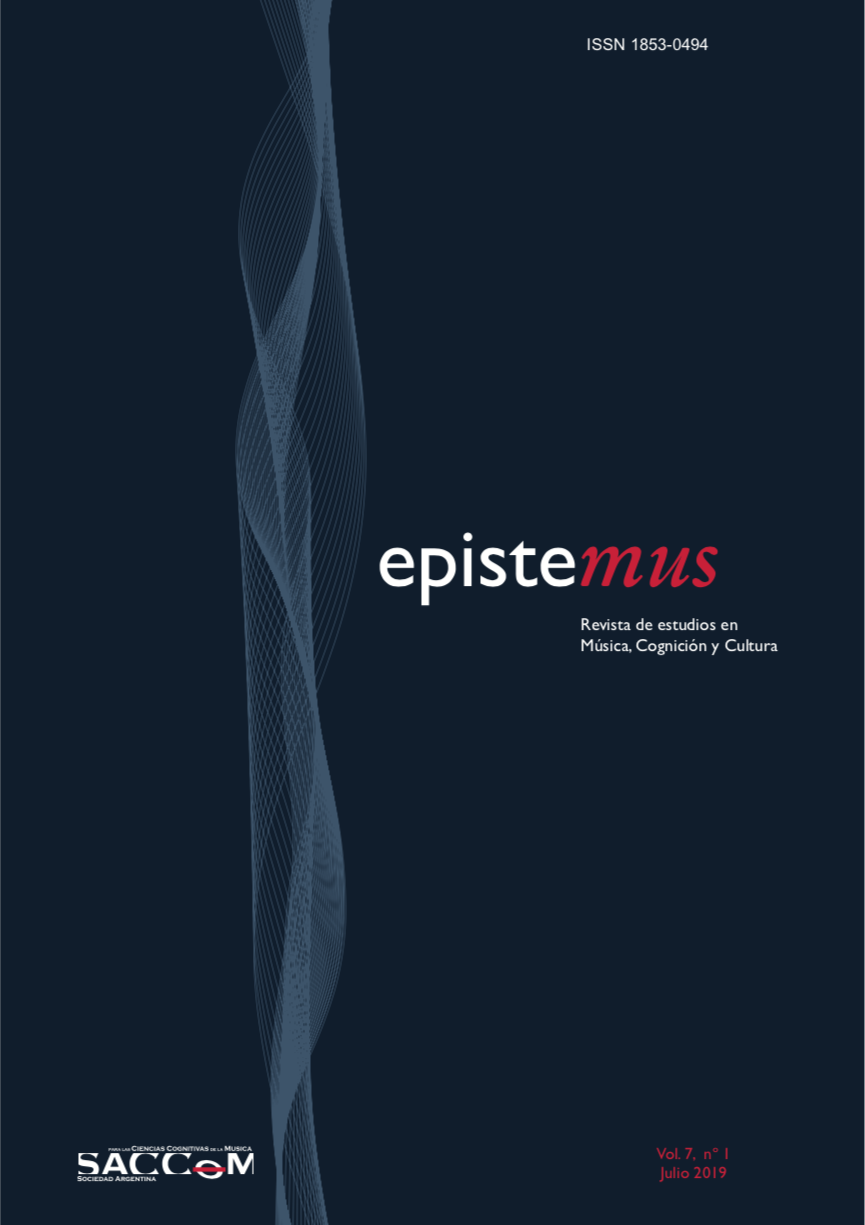O gesto musical e a construção interpretativa de obras contemporâneas brasileiras
DOI:
https://doi.org/10.24215/18530494e006Keywords:
music interpretation, interpretative construction, music gesture, contemporary Brazilian musicAbstract
This study aims to address issues that are still challenging the academic research in musical performance, especially related to the performer's gesture and the gestural conditions that determine the performance of the contemporary academic repertoire for piano. When we talk about instrumental performance, the way of doing it, that is, the way of interpreting, playing and planning the performance is relevant. The conscious development of the sequence of gestures that will constitute the instrumental performance determines in a significant way the interpretative construction. This is because the sound imagination leads the interpreter to the choice of the movements that will produce the differentiated intentional sounds, just as the gestual movements will imply imagined sonic configurations. This question arises when we deal with the interpretation of contemporary music, which contains a vast, growing repertoire that presents diverse tendencies. Because it is an interpretative practice under construction, not crystallized in consecrated aesthetic models, this practice demands from the performer interpretative decisions not foreseen in the pedagogical model that formed the interpreter. Thus, the challenges posed by the contemporary repertoire, which fuel the process of acquiring interpretative skills, emphasized in this research, contribute greatly to the pedagogy of musical performance, implying contributions to the recognition of the musical gesture within a network of elements from structures of unconventional interactions that structure the production of the musical gesture itself. The familiarity, experience and knowledge acquired by the performer about the expressive potential and the stylistic tendencies contained in the text of the work determine his musical understanding, and, consequently, the quality of the instrumental execution. The theoretical framework is based on the considerations and precepts of Robert Hatten (2004), George Kochevitsky (1967), Marc Leman (2008), Leonard Meyer (1989), among others.
Downloads
Metrics
References
Csekö, L.C. (2016). Noite do Catete 14. Edição do autor. 1 partitura (18 p.).
Ferraz, A. M. (2013). A liberdade na interpretação. Revista Interfaces, 1(18), 36-52.
Flusser, V. (2014). Gestures. (N. A. Roth, Trans.) Minneapolis, MN, USA: University of Minnesota Press.
Hatten, R. (2004). Interpreting Musical Gestures, Topics and Tropes. Blooming e Indianopolis: Indiana University Press.
Kaemper, G. (1968). Techniques pianistiques. Francia: Alfhonse Leduc et Cie - Éditions Musicales.
Kochevitsky, G. (1967). The art of piano playing: a scientific approach. Van Nuys: Summy- Birchard Inc.
Leman, M. (2008). Embodied Music Cognition and Mediation Technology. Cambridge, Massachu- setts: The MIT Press.
Leman, M., & Godøy, R. I. (2010). Why study musical gesture? En M. Leman y R. I. Godøy (Eds.), Musical gestures: Sound, movement, and meaning (pp. 3-11). Nueva York: Routledge.
Mannis, J. A. (2012). Processo criativo: do material à concretização, compreendendo interpretação-performance. Teoria crítica e música na atualidade (Série Simpósio Internacional de Músicologia da UFRJ), 2, 231-242.
Meyer, L. (1989). Style and Music: theory, history and ideology. Chicago: The University of Chicago Press.
Nascimento, G. (2001). Abacaxis não voam. Edição do autor. 1 partitura (6 p.).
Roubet, A. (2011). Interprétation. En: C. Accaoui (Ed.), Éléments d’esthétique musicale: notions, formes et styles en musique (pp. 257-272). Paris: Actes Sud / Cité de la musique.
Silverman, M. (2008). A performer’s creative processes: implications for teaching and learning musical interpretation. Music Education Research, 10(2), 249-269.
Souza, A. R. (2004). Ação e significação: Em busca de uma definição de gesto musical. São Paulo: Instituto de Artes, Universidade Estadual Paulista (UNESP).
Steuernagel, M. S. (2015). O gesto na composição musical. Revista Vórtex, 3(1), 146- 158.
Zampronha, E. (2010). Melodia. Edição do autor. 1 partitura (5 p.).
Downloads
Published
How to Cite
Issue
Section
License
Politica vigente desde octubre de 2019
La aceptación del manuscrito por parte de la revista implica la cesión no exclusiva de los derechos patrimoniales de los/as autores/as en favor del editor, quien permite la reutilización, luego de su edición (postprint), bajo una Licencia Creative Commons Atribución-NoComercial-CompartirIgual 4.0 Internacional (CC BY-NC-SA 4.0)
Acorde a estos términos, el material se puede copiar y redistribuir en cualquier medio o formato siempre que a) se cite la autoría y la fuente original de su publicación (revista y URL de la obra), se brinde el acceso a la licencia y se indique si se realizaron cambios; b) no se utilice el material para fines comerciales.
La cesión de derechos no exclusivos implica que luego de su edición (postprint) en Epistemus los/as autores/as pueden publicar su trabajo en cualquier idioma, medio y formato; en tales casos, se solicita que se consigne que el material fue publicado originalmente en esta revista.
Tal cesión supone, también, la autorización de los/as autores/as para que el trabajo sea cosechado por SEDICI, el repositorio institucional de la Universidad Nacional de La Plata, y sea difundido en las bases de datos que el equipo editorial considere adecuadas para incrementar la visibilidad de la publicación y de sus autores/as.
Asimismo, la revista incentiva a los/as autores/as para que luego de su publicación en Epistemus depositen sus producciones en otros repositorios institucionales y temáticos, bajo el principio de que ofrecer a la sociedad la producción científica y académica sin restricciones contribuye a un mayor intercambio del conocimiento global.

















